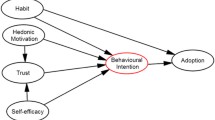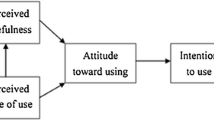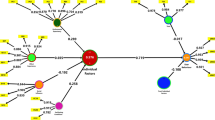Abstract
How and why individuals use Internet banking (IB) has attracted a great deal of academic attention. This article reviews the IB literature through the lenses of nine adoption theories. The review suggests that IB adoption is a complex and multifaceted process, and a joint consideration of customers’ personal, social, psychological, utilitarian and behavioural aspects is more important than adoption itself and will ultimately result in the intended behaviour. Therefore, managers and system developers should undertake a customer-centric approach focusing on managing belief formation rather than directly influencing behaviour. The review also concludes that IB research is in an inconclusive state, and is far from unanimamous regarding the approaches and conceptualizations used to understand the beliefs that truly influence IB behaviour. There is limited research dealing with the role of interventions that can assist managers in making effective decisions to speed the adoption process.
Similar content being viewed by others
References
Agarwal, R. and Prasad, J. (1999) Are individual differences germane to the acceptance of new information technologies? Decision Science 30 (2): 361–391.
Ajzen, I. (1985) From intentions to actions: A theory of planned behaviour. In: J. Kuhl and J. Beckman (eds.) Action-Control: From Cognition to Behaviour. Heidelberg, Germany: Springer, pp. 11–39.
Alsajjan, B. and Dennis, C. (2010) Internet banking acceptance model: Cross-market examination. Journal of Business Research 63 (9–10): 957–963.
Bandura, A. (1986) Social Foundations of Thought & Action: A Social Cognitive Theory. Englewood Cliffs, NJ: Prentice Hall.
Bateson, J.E.G. and Hoffman, K.D. (1999) Managing Services Marketing, 4th edn. London: Dryden Press.
Bauer, R. (1960) Consumer behaviour as risk-taking. In: R.S. Hancock (ed.) Dynamic Marketing for a Changing World. Chicago, IL: American Marketing Association, pp. 389–399.
Black, N., Lockett, A., Winklhofer, H. and Ennew, C. (2001) The adoption of internet financial services: A qualitative study. International Journal of Retail & Distribution Management 29 (8): 390–398.
Celik, H. (2008) What determines Turkish customers’ acceptance of internet banking? International Journal of Bank Marketing 26 (5): 353–370.
Chan, S. and Lu, M. (2004) Understanding internet banking adoption & use behaviour, a Hong Kong perspective. Journal of Global Information Management 12 (3): 21–43.
Chong, A., Ooi, K., Lin, B. and Tan, B. (2010) Online banking adoption: An empirical analysis. International Journal of Bank Marketing 28 (4): 267–287.
Davis, F.D. (1989) Perceived usefulness, perceived ease of use, & user acceptance of information technology. MIS Quarterly 13 (3): 19–339.
Eriksson, K. and Nilsson, D. (2007) Determinants of the continued use of self-service technology: The case of internet banking. Technovation 27 (4): 159–167.
Fishbein, M. and Ajzen, I. (1975) Belief, Attitude, Intention, & Behaviour: An Introduction to Theory & Research. Reading, MA: Addison-Wesley.
Gounaris, S. and Koritos, C. (2008) Using the extended innovation attributes framework and consumer personal characteristics as predictors of internet banking adoption. Journal of Financial Services Marketing 13 (1): 39–51.
Hernandez, J. and Mazzon, J. (2007) Adoption of internet banking: Proposition and implementation of an integrated methodology approach. International Journal of Bank Marketing 25 (2): 72–88.
Im, I., Hong, S. and Kang, M. (2010) An international comparison of technology adoption testing the UTAUT model. Information & Management 48 (1): 1–18.
Jaffee, D. (1998) Institutionalized resistance to asynchronous learning networks. Journal of Asynchronous Learning Networks 2 (2): 21–32.
Koenig-Lewis, N., Palmer, A. and Moll, A. (2010) Predicting young consumers’ take up of mobile banking services. International Journal of Bank Marketing 28 (5): 410–432.
Kuisma, T., Laukkanen, T. and Hiltunen, M. (2007) Mapping the reasons for resistance to internet banking: A means-end approach. International Journal of Information Management 27 (2): 75–85.
Lassar, W., Manolis, C. and Lassar, S. (2005) The relationship between consumer innovativeness, personal characteristics, & online banking adoption. International Journal of Bank Marketing 23 (2): 176–199.
Laukkanen, T. and Kiviniemi, V. (2010) The role of information in mobile banking resistance. International Journal of Bank Marketing 28 (5): 372–388.
Laukkanen, T. and Lauronen, J. (2005) Consumer value creation in mobile banking services. International Journal of Mobile Communications 3 (4): 325–338.
Laukkanen, P., Sinkkonen, S. and Laukkanen, T. (2008) Consumer resistance to internet banking: Postponers, opponents & rejectors. International Journal of Bank Marketing 26 (6): 440–455.
Lee, Y., Kozar, K. and Larsen, K. (2003) The technology acceptance model: Past, present, & future. Communication of the AIS 12 (50): 752–780.
Lee, E., Kwon, K. and Schumann, D. (2005) Segmenting the non-adopter category in the diffusion of internet banking. International Journal of Bank Marketing 23 (4): 414–437.
Lee, M. (2009) Factors influencing the adoption of internet banking: An integration of TAM and TPB with perceived risk and perceived benefit. Electronic Commerce Research and Applications 8 (3): 130–141.
Lippert, S. and Forman, H. (2005) Utilization of information technology: Examining cognitive & experiential factors of post-adoption behaviour. IEEE Transactions on Engineering Management 52 (3): 363–381.
Luarn, P. and Lin, H. (2005) Toward an understanding of the behavioral intention to use mobile banking. Computers in Human Behavior 21 (6): 873–891.
McKechnie, S., Winklhofer, H. and Ennew, C. (2006) Applying the technology acceptance model to the online retailing of financial services. International Journal of Retail & Distribution Management 34 (4/5): 388–410.
Moore, G. and Benbasat, I. (1991) Development of an instrument to measure the perceptions of adopting an information technology innovation. Information Systems Research 2 (3): 192–222.
Ostlund, L. (1974) Perceived innovation attributes as predictors of innovativeness. Journal of Consumer Research 1 (September): 23–29.
Ozdemir, S. and Trott, P. (2009) Exploring the adoption of a service innovation: A study of internet banking adopters and non-adopters. Journal of Financial Services Marketing 13 (4): 284–299.
Puschel, J., Mazzon, J. and Hernandez, J. (2010) Mobile banking: Proposition of an integrated adoption intention framework. International Journal of Bank Marketing 28 (5): 389–409.
Ram, S. (1987) A model of innovative resistance. In: M. Wallendorf and P. Anderson (eds.) Advances in Consumer Research, Vol. 14. Provo, Utah: Association for Consumer Research, pp. 208–215.
Ram, S. and Sheth, J. (1989) Consumer resistance to innovations: The marketing problem & its solutions. Journal of Consumer Marketing 6 (2): 5–14.
Read, W., McQuilken, L. and Robertson, N. (2010, December) A novel romance: Conceptualising emotional attachment as a barrier to adoption. Paper presented in the ANZMAC, Christchurch, New Zealand.
Rogers, E. (1962) Diffusion of Innovations. New York: Free Press.
Sathye, M. (1999) Adoption of internet banking by Australian consumers: An empirical investigation. International Journal of Bank Marketing 17 (7): 324–334.
Shih, Y. and Fang, K. (2006) Effects of network quality attributes on customer adoption intentions of internet banking. Total Quality Management 17 (1): 61–77.
Tan, M. and Teo, T. (2000) Factors influencing the adoption of internet banking. Journal of the AIS 1 (5): 1–42.
Taylor, S. and Todd, P.A. (1995) Understanding information technology usage: A test of competing models. Information Systems Research 6 (2): 144–176.
Venkatesh, V. (2000) Determinants of perceived ease of use: Integrating perceived behavioural control, computer anxiety & enjoyment into the technology acceptance model. Information Systems Research 11 (4): 342–365.
Venkatesh, V. and Bala, H. (2008) Technology acceptance model 3 & a research agenda on interventions. Decision Sciences Volume 39 (2): 273–315.
Venkatesh, V. and Davis, F. (2000) A theoretical extension of the technology acceptance model: Four longitudinal field studies. Management Science 46 (2): 186–204.
Venkatesh, V., Davis, F. and Morris, M. (2007) Dead or alive? The development, trajectory & future of technology adoption research. Journal of the AIS 8 (4): 267–286.
Venkatesh, V., Morris, M., Davis, G. and Davis, F. (2003) User acceptance of information technology: Toward a unified view. MIS Quarterly 27 (3): 425–478.
Yiu, C., Grant, K. and Edgar, D. (2007) Factors affecting the adoption of internet banking in Hong Kong – Implications for the banking sector. International Journal of Information Management 27 (5): 336–351.
Yousafzai, S., Foxall, G. and Pallister, J. (2010) Explaining internet banking behaviour: TRA, TPB, or TAM? Journal of Applied Social Psychology 40 (5): 1172–1202.
Yuen, Y., Yeow, P., Lim, N. and Saylani, N. (2010) Internet banking adoption: Comparing developed & developing countries. Journal of Computer Information Systems 51 (1): 2–61.
Zhou, T., Lu, Y. and Wang, B. (2010) Integrating TTF and UTAUT to explain mobile banking user adoption. Computers in Human Behavior 26 (4): 760–767.
Author information
Authors and Affiliations
Corresponding author
Rights and permissions
About this article
Cite this article
Yousafzai, S. A literature review of theoretical models of Internet banking adoption at the individual level. J Financ Serv Mark 17, 215–226 (2012). https://doi.org/10.1057/fsm.2012.19
Received:
Revised:
Published:
Issue Date:
DOI: https://doi.org/10.1057/fsm.2012.19




